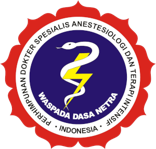Comparison Between Norepinephrine-Epinephrine and Norepinephrine-Vasopressin Effectiveness in Reducing Mortality in Septic Shock: A Systematic Review
Abstract
Background: Sepsis is a state of organ dysfunction caused by the immune system’s abnormal response to an infection. Septic shock is sepsis complicated by circulatory and metabolic abnormalities, oftentimes resulting in death. Prompt identification and treatment of septic shock is crucial for the survival of patients. The latest international guideline recommends the administration of norepinephrine as the first line vasopressor, with the addition of epinephrine or vasopressin as an aid in achieving the target MAP (Mean Arterial Pressure).
Methods: This study is a systematic review of literatures from the databases Pubmed PMC, Science Direct, and Proquest. Systematic reviews on septic shock, norepinephrine, and epinephrine or vasopressin were among the inclusion criterias. This resulted in a total of five systematic reviews to be included in the qualitative synthesis.
Results: The five included studies were not in sync as to which vasopressor is best used for the treatment of septic shock patients. One of which did not compare the two combinations within the same category, two of which favored the use of norepinephrine-epinephrine, and the other two favored the use of norepinephrine-vasopressin for the treatment of septic shock patients.
Conclusion: The existing evidence were insufficient to give a conclusion of the best combination of vasopressors for septic shock patients. More research, specifically randomized controlled trials, needs to be conducted on this topic with well defined administration of combinations of vasopressors as an advancement of this systematic review. The writers also recommend the delay of anymore systematic reviews until the former recommendation has been met.
Keywords
Full Text:
PDFReferences
1. Singer M, Deutschman CS, Seymour C, Shankar-Hari M, Annane D, Bauer M, et al. The third international consensus definitions for sepsis and septic shock (sepsis-3). JAMA - J Am Med Assoc. 2016;315(8):801–10.
2. World Health Organization. Sepsis [Internet]. who.int. 2018 [cited 2022 May 6]. Available from: https://www.who.int/health-topics/sepsis#tab=tab_1
3. Fleischmann C, Scherag A, Adhikari NKJ, Hartog CS, Tsaganos T, Schlattmann P, et al. Assessment of global incidence and mortality of hospital-treated sepsis current estimates and limitations. Am J Respir Crit Care Med. 2016;193(3):259–72.
4. Rhee C, Dantes R, Epstein L, Murphy DJ, Seymour CW, Iwashyna TJ, et al. Incidence and trends of sepsis in US hospitals using clinical vs claims data, 2009-2014. JAMA - J Am Med Assoc. 2017;318(13):1241–9.
5. Phua J, Koh Y, Du B, Tang YQ, Divatia J V., Tan CC, et al. Management of severe sepsis in patients admitted to Asian intensive care units: Prospective cohort study. Bmj. 2011;342(7812).
6. Mohammadi K, Movahhedy MR, Khodaygan S, Gutiérrez TJ, Wang K, Xi J, et al. keputusan menteri kesehatan republik indonesia nomor hk.01.07/menkes/342/2017 tentang. adv Drug Deliv Rev [Internet]. 2017;135(January 2006):989–1011. Available from: https://doi.org/10.1016/j.addr.2018.07.012%0Ahttp://www.capsulae.com/media/Microencapsulation - Capsulae.pdf%0Ahttps://doi.org/10.1016/j.jaerosci.2019.05.001
7. Rhodes A, Evans LE, Alhazzani W, Levy MM, Antonelli M, Ferrer R, et al. Surviving Sepsis Campaign: International Guidelines for Management of Sepsis and Septic Shock: 2016. Vol. 45, Critical Care Medicine. 2017. 486–552 p.
8. Evans L, Rhodes A, Alhazzani W, Antonelli M, Coopersmith CM, French C, et al. Surviving sepsis campaign: international guidelines for management of sepsis and septic shock 2021. Intensive Care Med [Internet]. 2021;47(11):1181–247. Available from: https://doi.org/10.1007/s00134-021-06506-y
9. Jentzer JC, Vallabhajosyula S, Khanna AK, Chawla LS, Busse LW, Kashani KB. Management of Refractory Vasodilatory Shock. Chest [Internet]. 2018;154(2):416–26. Available from: https://doi.org/10.1016/j.chest.2017.12.021
10. Cheng L, Yan J, Han S, Chen Q, Chen M, Jiang H, et al. Vasopresores Sepsis. 2019;1–14.
11. Zhou F, Mao Z, Zeng X, Kang H, Liu H, Pan L, et al. Vasopressors in septic shock: A systematic review and network meta-analysis. Ther Clin Risk Manag. 2015;11:1047–59.
12. Chen C, Pang L, Wang Y, Wen T, Yu W, Yue X, et al. Combination era, using combined vasopressors showed benefits in treating septic shock patients: a network meta-analysis of randomized controlled trials. Ann Transl Med. 2019;7(20):535–535.
13. McIntyre WF, Um KJ, Alhazzani W, Lengyel AP, Hajjar L, Gordon AC, et al. Association of vasopressin plus catecholamine vasopressors vs catecholamines alone with atrial fibrillation in patients with distributive shock a systematic review and meta-Analysis. JAMA - J Am Med Assoc. 2018;319(18):1889–900.
14. Oba Y, Lone NA. Mortality benefit of vasopressor and inotropic agents in septic shock: A Bayesian network meta-analysis of randomized controlled trials. J Crit Care [Internet]. 2014;29(5):706–10. Available from: http://dx.doi.org/10.1016/j.jcrc.2014.04.011
15. Russell AJ, Hébert PC, Cooper DJ, Holmes CL, Mehta S, Granton JT, et al. Vasopressin versus Norepinephrine Infusion in Patients with Septic Shock. N Engl J Med. 2008;358(9):877–87.Refbacks
- There are currently no refbacks.








